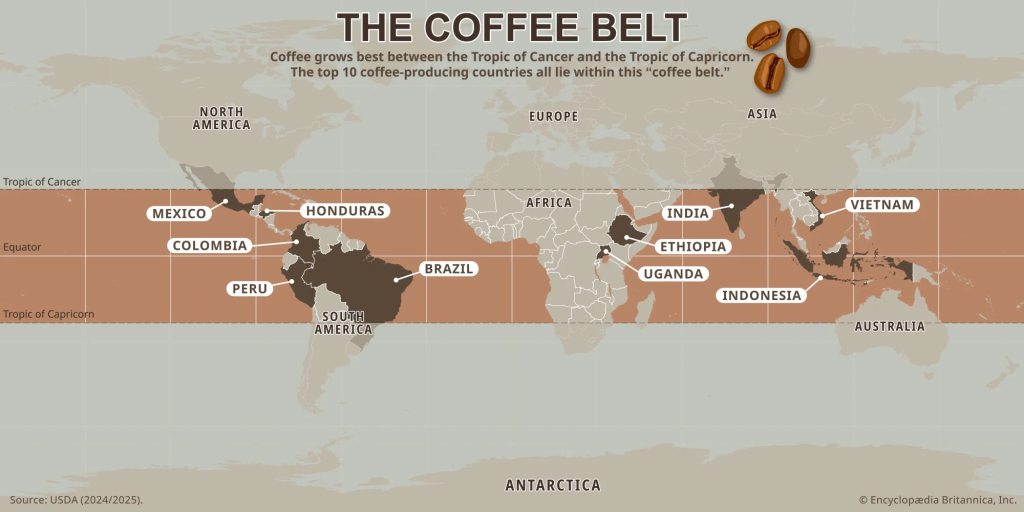African vs. Latin American Coffee: What Makes It Unique?

Coffee is one of the most consumed beverages in the world, and two regions dominate the specialty market: Africa and Latin America. While both are known for producing high-quality beans, their differences in history, geography, processing methods, and flavor profiles set them apart in fascinating ways.
In this article, we’ll dive into the unique qualities of African vs. Latin American coffee, explain what makes them distinct, and explore how coffee lovers can appreciate both sides of the globe in every cup.
Historical Roots: Where Coffee Began
- Africa – The Birthplace of Coffee
Coffee’s journey began in Ethiopia more than a thousand years ago, where legend tells of Kaldi, the goat herder who discovered the energizing effects of coffee cherries. From Ethiopia, coffee spread across Yemen, the Middle East, and eventually to Europe. - Latin America – The Expansion of Coffee
Coffee arrived in Latin America in the 18th century, introduced by European colonizers. The region’s vast landscapes, rich soils, and tropical climates proved ideal for large-scale cultivation. Today, countries like Brazil and Colombia dominate global exports.
Key takeaway: African coffee represents origin and tradition, while Latin America reflects expansion and industrial scale.

Geography and Climate Differences
Both regions benefit from climates ideal for coffee, but they differ in terrain and altitude:
- Africa:
- Grown at higher elevations (1,200–2,200 meters).
- Volcanic soils and diverse microclimates in East Africa.
- Produces dense beans with bright acidity.
- Latin America:
- Altitudes vary from 800–2,000 meters.
- Fertile soils in the Andes and Central America.
- Produces balanced coffees with smooth textures.
Result: African beans tend to have livelier flavors and floral notes, while Latin American beans are more rounded and approachable.
Processing Methods: Tradition vs. Innovation
- Africa:
- Washed (wet) processing dominates, highlighting clarity and acidity.
- Ethiopia also uses natural (dry) methods, producing fruity, wine-like coffees.
- Smallholder farms focus on hand-picked cherries and community processing stations.
- Latin America:
- Uses both washed and honey processes, with innovation in fermentation.
- Countries like Brazil specialize in mechanized natural processing on large estates.
- Strong emphasis on consistency and volume.
Result: African coffee often showcases complex, experimental profiles, while Latin American coffee emphasizes balance, smoothness, and scalability.
Flavor Profiles: Africa vs. Latin America
African Coffee
- Ethiopia: Floral, citrusy, tea-like (Yirgacheffe, Sidamo).
- Kenya: Bold acidity, blackcurrant, wine-like flavors.
- Rwanda & Burundi: Red fruits, caramel sweetness.
- Uganda: Strong earthy Robusta and chocolatey Arabica.
Overall flavor: Bright, fruity, floral, and adventurous.
Latin American Coffee
- Brazil: Nutty, chocolatey, mild acidity, full-bodied.
- Colombia: Balanced, smooth, caramel and citrus.
- Costa Rica: Clean, bright, with honey sweetness.
- Guatemala: Complex, spicy, and full-bodied.
Overall flavor: Smooth, balanced, sweet, and approachable.
Coffee Culture: Tradition and Community
- Africa:
- Ethiopia’s coffee ceremony is central to community life.
- Coffee is not just a beverage, but a cultural ritual.
- Smallholders dominate the industry, with farms often less than 2 hectares.
- Latin America:
- Coffee is a pillar of national identity in countries like Colombia and Brazil.
- Festivals, tourism, and branding campaigns (e.g., Juan Valdez in Colombia).
- Strong integration with global specialty markets.
Market Influence and Economic Role
- Africa: Specialty coffee focus. Although volumes are lower, African coffees often fetch premium prices in international markets.
- Latin America: The largest exporters of coffee worldwide, with Brazil alone supplying about 40% of the global market.
Conclusion: Latin America drives scale and accessibility, while Africa delivers prestige and specialty appeal.
How to Choose Between African and Latin American Coffee
- If you love adventure: African coffees will surprise you with floral and fruity notes. Perfect for pour-over lovers.
- If you prefer comfort and balance: Latin American coffees provide smooth chocolate, caramel, and nutty flavors, ideal for espresso or milk-based drinks.
- Best approach: Explore both — rotate between regions to discover the full spectrum of global coffee.
FAQs on African vs. Latin American Coffee
Q1: Which region produces better coffee?
Neither is objectively better; it depends on taste. Africa offers complexity and brightness, while Latin America is known for balance and sweetness.
Q2: Is African coffee more expensive than Latin American?
Often yes, because of smaller volumes, labor-intensive harvesting, and specialty demand.
Q3: What brewing method best suits African coffee?
Pour-over methods like V60 or Chemex highlight its floral and fruity notes.
Q4: Why is Latin American coffee more common in supermarkets?
Because countries like Brazil and Colombia produce massive quantities, ensuring availability worldwide.